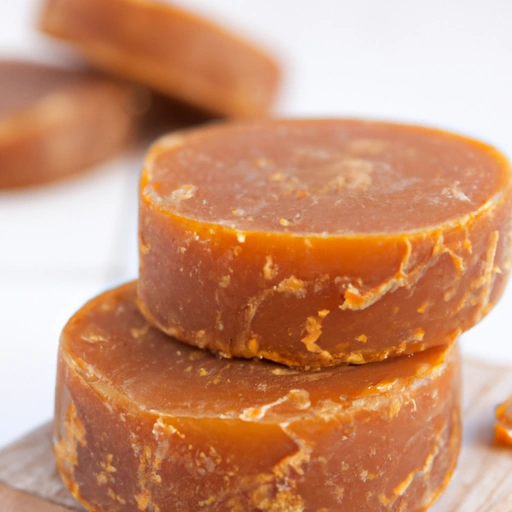Jaggery
Description

Jaggery is a traditional, unrefined sugar obtained from raw, concentrated sugarcane juice. Unlike refined sugar, it is less processed and retains more plant minerals and molasses. Its color ranges from golden brown to dark brown and it's commonly found in solid blocks, granules, or a soft, pasty form. Jaggery is known for its rich, molasses-like flavor which adds a unique depth to dishes. It is measured in grams (g) or ounces (oz) for weight, and teaspoons (tsp), tablespoons (tbsp), or cups (c) for volume in recipes.
Common uses
Jaggery is widely used as a sweetening agent in various desserts and sweet treats, as well as in savory dishes to balance flavors. It is also consumed directly in small chunks for its purported health benefits or dissolved in hot beverages as a substitute for sugar.
Nutritional value
Calories
Jaggery contains about 383 calories per 100 grams (3.5 oz).
Protein
It provides approximately 0.4 grams of protein per 100 grams (3.5 oz).
Fat
Jaggery contains negligible amounts of fat.
Carbohydrates
It is primarily composed of carbohydrates, with about 98 grams per 100 grams (3.5 oz), predominantly in the form of sucrose.
Vitamins
Jaggery is a source of B-vitamins, particularly B-complex vitamins like thiamine and riboflavin.
Minerals
It is rich in minerals such as iron, magnesium, potassium, and manganese.
Health benefits
The consumption of jaggery is associated with several health benefits, including aiding digestion, acting as a detoxifying agent for the body, and potentially providing relief from cold and cough symptoms due to its warming effect.
Potential risks
Despite its health benefits, overconsumption of jaggery can lead to weight gain due to its high caloric content. Individuals with diabetes should also be cautious as it can lead to spikes in blood sugar levels.
Common recipes
Jaggery is used in traditional desserts such as gur ka halwa, payasam, and til gud laddoo. It's also used to sweeten beverages like tea and in the preparation of jaggery rice.
Cooking methods
It can be melted down and used in syrups, incorporated into doughs and batters, or used to caramelize and enhance the flavor of certain dishes.
Pairing with other ingredients
Jaggery pairs well with ingredients like ginger, cardamom, coconut, and fennel seeds, enhancing the sweetness and adding a complex flavor profile to dishes.
Summary
Jaggery is a versatile and nutritious sweetener with historical significance and a range of culinary applications. It offers a healthier alternative to refined sugar while contributing a distinct flavor to a variety of dishes.